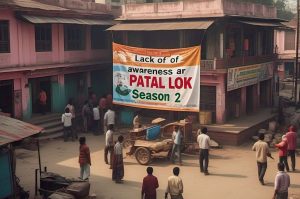Paatal Lok Season 2: The second season of Amazon Prime Video’s “Paatal Lok” has made a dramatic and unusual turn in Indian streaming entertainment by focusing on Nagaland, a region that has long been overlooked or misrepresented in Hindi movies. This transition not only provides a new narrative perspective, but it also plays an important role in combating long-held misconceptions about North-east India in mainstream Indian media. By weaving authentic cultural elements into its gripping storyline, “Paatal Lok” Season 2 sets a new standard for Hindi-language web series and films.
Paatal Lok Season 2: A New Lens on Northeast India
The decision to focus on Nagaland in Season 2 of “Paatal Lok” is noteworthy. The region has frequently been depicted in Hindi movies as either exotic or conflict-ridden, with little emphasis on its rich culture, traditions, and daily life. By incorporating Nagaland into its story, “Paatal Lok” draws attention to an area that has long been overlooked in popular debate.

One of the season’s defining features is its emphasis on authenticity. The usage of the Nagamese language in talks, rather than forcing characters to speak accented Hindi, is a major changer in Indian entertainment. This option respects India’s linguistic variety while also allowing the Naga characters to be portrayed in a realistic and engaging manner. As critics have highlighted, this technique challenges Hindi’s dominance in Indian narrative while also acknowledging the country’s linguistic plurality.
Paatal Lok Season 2: Authentic Representation of Naga Culture
For decades, North-east Indians have been stereotyped in Bollywood films as either “Chinese-looking” characters speaking bad Hindi or criminals engaging in drug trafficking and insurgency. “Paatal Lok” departs from these reductive representations by showing the Naga community in complexity and depth.
The series incorporates traditional Naga dress, rituals, and practices, presenting them in a way that feels natural to the tale rather than purely decorative. From the meticulously built set pieces that mimic authentic Naga villages to the incorporation of local festivities, “Paatal Lok” Season 2 does not exoticize Naga culture, but rather shows it with respect and precision.
Paatal Lok Season 2: The Storyline – A Murder That Unveils Deeper Issues
At the heart of the story is a murder mystery set in Nagaland. The death of Jonathan Thom, a powerful Naga leader, at a Delhi hotel triggers a series of events that brings protagonist Hathiram Chaudhary, played by Jaideep Ahlawat, to the region. As he goes deeper into the research, he meets persons who represent the many and frequently misunderstood facets of Naga society.


The show introduces Merenla Imsong as Rose Lizo, and Jahnu Baruah as Ken, a former rebel leader. Their experiences connect with the major plot, bringing light on issues of identity, politics, and migration. These people are more than just footnotes; they help shape the story and provide insight into how Nagaland interacts with the rest of India.
Paatal Lok Season 2: Insider vs. Outsider Dynamics – A Recurring Theme
One of the most interesting themes in “Paatal Lok” Season 2 is the investigation of insider-outsider relations, namely how Nagaland perceives itself in relation to the rest of India. The show focuses on the Inner Line Permit system, which is a legislative framework that governs non-local admission into certain areas of the North-east. This policy, while intended to conserve indigenous traditions, creates a sense of alienation.
This emotion is encapsulated in a memorable moment where a Bihari taxi driver yells “permit, permit!” to new arrivals at Kohima airport. As a foreigner attempting to earn a livelihood in Nagaland, his presence draws attention to the difficulties associated with migration, identification, and belonging. The programme discusses these topics in a way that promotes debate and introspection rather than taking a binary approach.
Breaking Stereotypes of Northeast India in Hindi Cinema
North-east characters have frequently been relegated to one-dimensional parts in mainstream Hindi films, typically as antagonists or sidekicks. For decades, men have been portrayed as either criminals or rebels, while women from the North-east are portrayed as “mysterious” or “exotic beauties”. “Paatal Lok” dispels these misconceptions by providing its Naga characters with nuance, personal goals, and agency.


The series sensitively portrays the region’s problems, including drug trafficking, political corruption, and conflict, without holding back. Instead of exploiting these problems as dramatic plot points, “Paatal Lok” offers background information by examining the sociopolitical and historical contexts.
A Balanced Perspective on Militancy and Political Turmoil
Another noteworthy aspect of “Paatal Lok” Season 2 is its treatment of militancy and political unrest in Nagaland. Unlike earlier Hindi films that have either vilified insurgent groups or romanticized them, the show takes a more nuanced approach. It presents different perspectives—those of former rebels, government officials, and ordinary citizens—without glorifying or demonizing any particular group.


This balanced perspective is crucial in fostering a more informed understanding of the Northeast. The series humanizes individuals on all sides of the conflict, showing their motivations and struggles rather than reducing them to simplistic good-versus-evil narratives.
Paatal Lok Season 2: The Power of Local Storytelling in Hindi Entertainment
“Paatal Lok” Season 2 sets a new precedent for how Hindi entertainment can incorporate regional narratives without appropriating or distorting them. The series’ success demonstrates that audiences are willing to engage with stories set outside the usual Hindi-speaking belt, as long as they are told with authenticity and depth.


This shift could pave the way for more filmmakers to explore narratives from the Northeast, ensuring that the region is no longer treated as an “exotic” backdrop but as a central and equal part of India’s storytelling landscape. It also highlights the importance of casting actors from the region itself, rather than using North Indian actors in “Northeast-looking” roles, a problematic trend that has persisted in Bollywood.
Paatal Lok Season 2: Impact on the Representation of Northeast India in Indian Media
The success of “Paatal Lok” Season 2 has broader implications for the representation of Northeast India in Indian media. It proves that audiences appreciate well-researched, respectful portrayals of marginalized communities. By breaking away from stereotypes and presenting Northeast characters as fully realized individuals, the show contributes to a more inclusive and representative Indian media industry.
This shift also aligns with a growing movement in Indian entertainment toward regional storytelling. With streaming platforms providing greater flexibility than traditional Bollywood productions, there is now more space for stories that reflect India’s cultural diversity. “Paatal Lok” Season 2 is a testament to how powerful and compelling such storytelling can be.
Paatal Lok Season 2: A Landmark Achievement in Indian Entertainment
“Paatal Lok” Season 2 is more than just a crime thriller; it is a groundbreaking work that brings Northeast India to the forefront of Hindi entertainment. By prioritizing authenticity, presenting complex characters, and addressing important socio-political issues, the series sets a new benchmark for how regional narratives can be integrated into mainstream storytelling.
As Indian cinema and web series continue to evolve, the impact of “Paatal Lok” will likely be felt for years to come. It serves as an example of how entertainment can be both engaging and enlightening, challenging outdated stereotypes while opening doors for more diverse and inclusive narratives in Indian media.
With its gripping storyline, authentic representation, and thought-provoking themes, “Paatal Lok” Season 2 is not just a show to watch—it is a show to remember, discuss, and learn from.
Also read: Paatal Lok Season 2 Northeast India Representation

